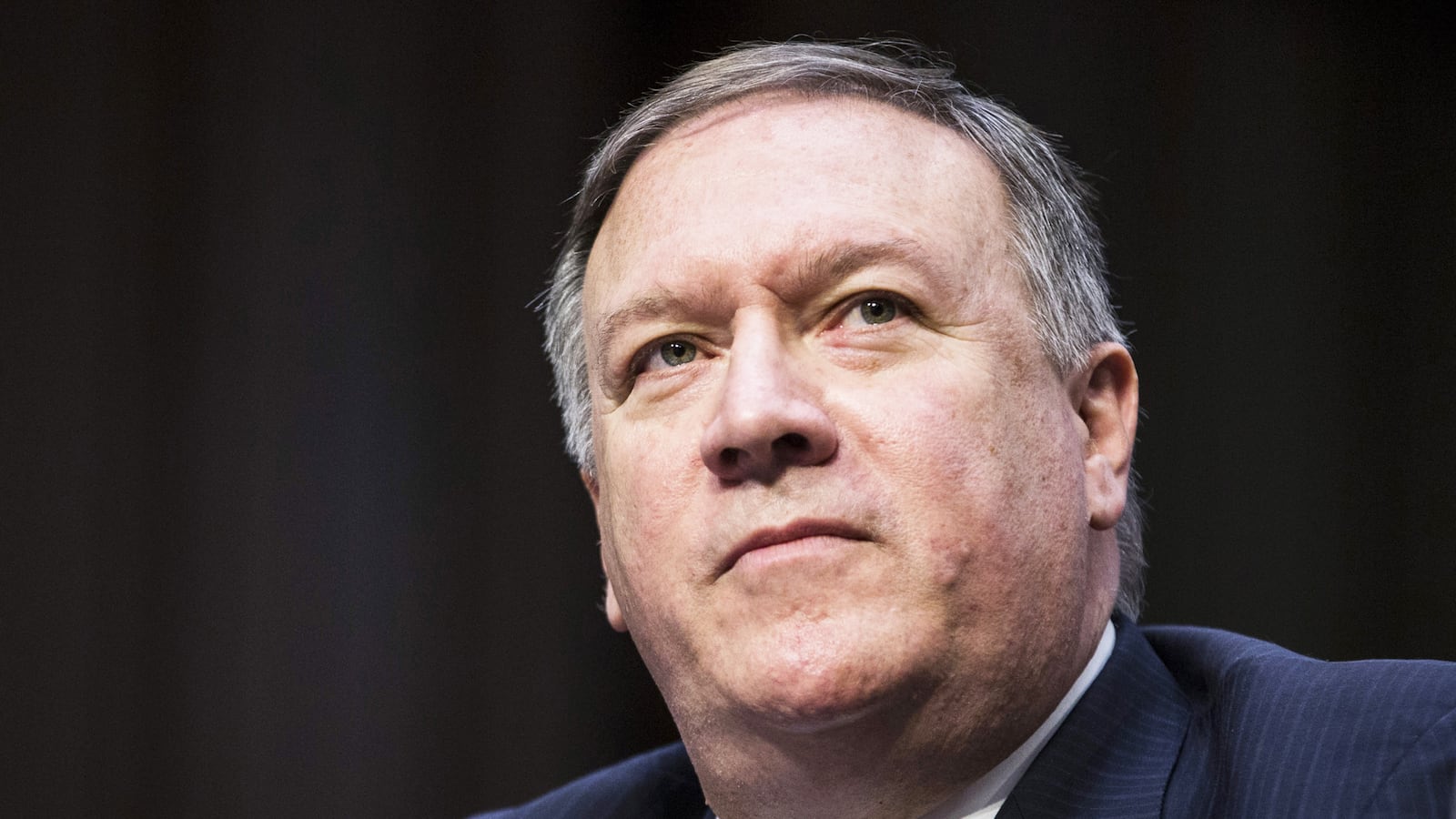Don’t expect the agonizing process of North Korean “denuclearization” to gain speed as Secretary of State Mike Pompeo goes to Pyongyang this weekend to plead with Kim Jong Un to do something, anything, to show he’s getting rid of the arsenal that he persists in holding as a club over the U.S.
The improbability of Pompeo making substantive progress was manifest this week when South Korean Foreign Minister Kang Kyung-wha put forth the bizarre notion that the U.S. should forget about North Korea revealing the whereabouts of its far-flung stockpiles of nuclear weapons and facilities for making them. Instead, she suggested, why not settle for the North shutting down its increasingly decrepit nuclear complex at Yongbyon, 60 miles north of Pyongyang?
Nobody’s sure if President Donald Trump is listening, but Daniel Russel, who served as assistant secretary of state during some of the toughest moments of the North Korean standoff earlier in the decade, scoffs at letting “North Korea set the agenda and come up with half-baked measures” that enable the North “to demand concessions.”
In the case of Kang’s proposal, as reported by The Washington Post, the U.S. would simply have to forget about one of the most vital elements in any deal: the inventory.
The Americans keep asking where the hell the North Koreans are manufacturing all their nukes and missiles. Where are they storing them? And what exactly do they have besides that ancient five-megawatt reactor at the Yongbyon complex that’s produced the plutonium for dozens of warheads but is now ready for the scrapheap?
As far as Kang is concerned, all the Americans need do to get the North Koreans to close the Yongbyon complex is agree to an end-of-war “peace declaration” or peace treaty in place of the armistice that ended the fighting in on the Korean Peninsula in July 1953.
One might ask why bother, given that during the peace that’s prevailed for more than 65 years South Korea has risen to spectacular economic heights while North Korea has squandered its resources on nukes and missiles that, one hopes, never will be used? But one might also ask about that peace treaty, why not?
Russel, now vice president of the Asia Society, explains: “It’s a mistake to take the bait of a peace treaty” or even a mere declaration stating, more or less, look, we’re not fighting anyone. “A peace declaration or end-of-war declaration is at best a diversion from the real issue of denuclearization,” he said at a symposium staged in Washington by the Institute for Corean [sic] American Studies. “More likely,” he added, it would mean the end of the mission of U.S. forces to defend the South as they have done ever since the North Korean invasion of June 1950.
Pompeo and the American team concerned with core issue of North Korean nukes face two major problems right now.
The first is that Kang’s boss, South Korean President Moon Jae-in, is totally committed to the idea of getting the parties to the 1953 truce –North Korea, the U.S. and China – to go for what the Americans see as this phony end-of-war declaration by the end of this year.
The second problem is Trump. Nobody knows what the hell he might do. Can Pompeo, hopefully shrugging off Kang’s fatuous proposal, get something going when he sees Kim Jong Un on Sunday, or will he just go there for “party planning,” as Russel put it, preparing for a second Trump-Kim summit.
You have to go back to the first Trump-Kim séance in Singapore nearly four months ago to grasp just how unpredictably Trump might behave in his quest to get along with a leader with whom he “fell in love,” as, honestly, he did say recently.
Nobody in the Pentagon, the State Department or even the National Security Council, which is really an extension of the White House, had a clue that Trump would agree to cancelling joint U.S.-South Korea military exercises when he saw Kim. Nor was anyone the least prepared for Trump calling such war games “provocative” – a word straight out of the North Korean lexicon.
Whatever understanding Pompeo goes for on his fourth mission to the North Korean capital, he cannot forget that Trump may prefer to make a dramatic gesture, maybe even that “peace declaration,” against all advice from his closest aides, including hawkish National Security Adviser John Bolton.
Indeed, Kang’s remarks left the impression that President Moon, when he saw Kim in Pyongyang last month, had talked over the basic preliminary deal that she portrayed as “a huge step forward” for denuclearization.
There is no doubt Moon and his closest aides are genuinely excited about what they see as an historic bid to bring about great relations between South and North – and they just can’t understand why South Korean conservatives, not to mention American military and diplomatic experts, are so skeptical.
“We have a chance to heal the pain of inter-Korean division and cast away our perpetual fear of war,” Kim Eui-kyeom, a media aide at the Blue House, the center of presidential power, said earlier this year. “But it’s also true,” Kim added, “that this moment could be described as a candle in the wind.”
Remember that before the Singapore summit, the U.S. position was that no sanctions would be lifted until there was CVID: complete, verifiable, irreversible denuclearization. Since Singapore, those absolutist initials no longer seem to be part of the conversation.
The controversial compromise and concessions Moon and Kang espouse raise endless issues about the verification of dismantling at the Yongbyon complex. Just who would confirm its dismantlement? And could inspectors return periodically to make sure it was still shut down? Those are just a couple of the questions that clearly need answering.
North Korea’s stubborn refusal to provide a list of all its missile and nuclear facilities, moreover, adds to the doubts about whether any deal has a chance of working.
“The North Koreans have consistently played a game,” said Larry Niksch, who spent years at the Congressional Research Service studying North Korea issues. “We have never gotten into what is beyond Yongbyon.” The question, he said, is “how could we get them to get into negotiations outside Yongbyon into the rest of North Korea.”
Evans Revere, a former senior official at the State Department and the U.S. embassy in Seoul, agrees with such doubts. “We’d be fools to take this offer,” he said of Kang’s call for a step-by-step process. “The goal of North Korea is to undermine the validity and the viability of the U.S.-Republic of Korea alliance and the rationale for the U.S. military presence.” The proposal, he said, “plays into their hands.”
But always there is Trump, whose mind sometimes seems as difficult to fathom as that of Kim Jong Un.
After having excoriated Kim last year as “rocket man” and warned of the “fire and fury” that would descend on North Korea if the North fired nuclear-tipped missiles at the U.S., he’s come out with such honeyed words as to suggest he’s either fallen for Kim’s wiles or, perhaps, is trying to fool him into thinking he’s really his friend. He sounded almost as if he were engaged in a real romance, citing those “beautiful letters … great letters” that Kim had written him as the two “fell in love.”
But then Trump at the U.N. General Assembly last month said sanctions would remain in place until North Korea gives up its nukes and missiles, and North Korea has said it won’t do anything until the U.S. takes “corresponding measures,” including an end of sanctions plus the end-of-war declaration.
In fact, the U.S. and North Korea are following a two-track policy in which Trump and Kim woo each other with kind words and flattery while the U.S. ostensibly sticks to its demands for an end to North Korea’s nuclear program. But it’s not at all clear whether the two tracks converge, much less whether they will achieve their goals.
Some analysts believe that Trump, first by threatening North Korea , then by pursuing a diplomatic track, may be getting somewhere. “First you soften them, then you deal with them,” said David Ignatius, Washington Post columnist and author, explaining Trump’s foreign policy modus operandi in a lecture at Princeton University. “We begin to see what a new deal would look like. … The outlines are beginning to emerge.”
The outlines, though, are blurred. By flattering Kim, the Trumpster may think the Kimster will have no choice but to come to terms. While the content of Kim’s letters and messages to Trump have not been revealed, it’s safe to say Kim is pursuing a similar strategy toward Trump, playing on his gargantuan ego in order to wring concessions that will do nothing to bring about “denuclearization” as vaguely promised at their tryst in Singapore.
The bottom line: Kim and Moon are pushing for peace in our time, to coin a phrase, not peace on Trump’s original terms. Pompeo may find that unacceptable, but Trump? Nobody knows.





